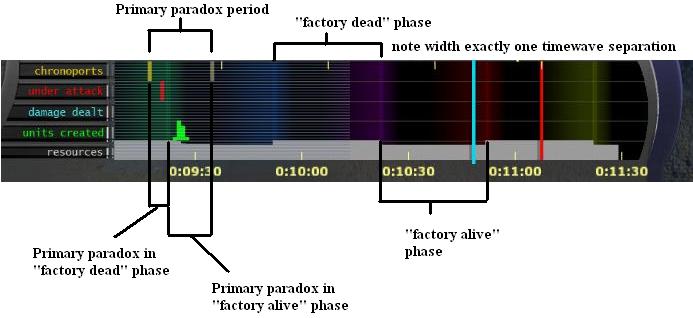Paradox
A paradox is a situation which prevents a self-consistent timeline. A paradox can only arise from the use of timetravel. In Achron, the timeline will tend to fluctuate between alternate resolutions of a paradoxed state.
A paradox left to propagate by itself with no outside interference will oscillate from one state to another. The rate of oscillation is dependent on when the next state becomes available for a new natural timewave to operate on. The smallest paradoxes change state every timewave. Backwards chronoports and long time distances in the propagation path might cause the paradox to require additional timewaves to sweep over it before a change of state happens. Because all changes done to the timeline propagate only via the next wave the natural oscillation rates must be multiplies of the sweep rate. A paradox that length would fall in-between such times might be able to be manually propagated faster by a player working as an extra propagator.
Here is a timeline from a factory building a lot of mechs and one of them chornoporting backwards to kill it before any are built.

Contents |
Paradox Phase
(needs better explanation)
Paradoxes being oscillating entities have a certain achronal time structure. The phase of a paradox refers to which particular state of the oscillation is currently(RT) manifested as the game state between the bounds of the paradox.
For example a classic mech-factory grandfather paradox has 2 phases which it cycles between:
- The mech is alive and the factory is dead.
- The mech is dead and the factory is alive.
Since they are cyclic and naturally propagate only via timewaves, it follows that they contain only as many main phase states as the number of timewaves needed to update them Paradox Length. Timewaves after the paradox may have similarly cycling game states.
If these cyclicals span a long time it is possible that one part of the assembly is in one phase where one part is in another. In the unit-factory example if the paradox switches states every timewave but the unit makes a interaction that has the effects play out in a duration that can accommodate 4 timewaves, waves 1 and 3 might be in "unit alive" while waves 2 and 4 are in "unit dead".
Parallel Paradoxes
For paradoxes of equal length they will retain the same phase. For example if two dead-alive grandfather paradoxes of equal length are started so that when one is in "alive" the other is in "dead" this will remain. Thus the "alive" states never meet. This can make paradoxed scouts miss out of synch paradoxed stuff.
If the lengths are unequal, the relative phase will change. Lengths of 5 and 6 will experience all relative phases in 30 timewave sweeps then 6 cycles for 5 length have passed and 5 cycles for the 6 length . With smaller relative length differences this happens faster with 3 and 2 length doing the same in 6 passings.
A pair of paradoxes can thus be in 4 distinct states.
Interacting paradoxes
A paradoxed unit can try to paradox itself even further down its own past. This forms a Meta-paradox. Doing it future to the original destruction event will only form a Subparadox
Calculating Paradoxes
It is possible to predict how to start a paradox that will resolve in a particular way. The formula would involve timewave separation and amount of waves that will sweep, as well as desitance to the past edge and the speed of the present. Timeline altercations may disturb such a rigged paradox. As a whole it remains elusive that one could count on making a paradox that ends "favourably". Capacity to do so would have immidiate applications in Chronocloning.